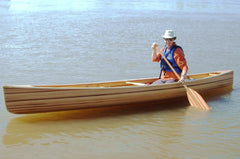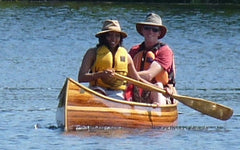The Right Tool for the Job: What You Need to Build a Canoe

When you're about to embark on your first canoe build, naturally you'll want to outfit your workshop with the right tools. Even if you're just beginning to think about the process, knowing what's involved can help you decide whether canoe-building is for you.
Although our primary advice is to read Canoecraft two or three times before you begin, we thought an online list of recommended tools might come in handy. If the list looks lengthy, be reassured that not everything here is essential. You can even build a canoe using just hand tools, so long as you're aware that certain aspects may be much more time-consuming.
Exactly what you'll need also varies on whether you purchased a kit or are working from scratch. For instant, kit builders won't need to work about cutting out their station molds with a saber saw or band saw. Tools that are helpful but completely optional in either case are marked as such, and alternative choices are given in the comments column.
Simple tools made from scrap wood (e.g. jigs and push sticks) aren't included here. Instead, the relevant chapters of Canoecraft describe elements like this that can be made at home.
| TOOL | USE | COMMENTS |
| Cutting Tools | ||
| Portable circular saw (optional) | Cutting strongback parts | |
| Saber saw | Cutting out station molds and decks | Alternative: band saw |
| Crosscut handsaw | Cutting straight lines | |
| Coping saw | Trimming planks | Alternatives: Japanese razor saw, dovetail saw, or backsaw |
| Table saw | Ripping planks, gunwales, keel | Use hollow-ground combination planer blade |
| Dovetail saw | Cutting hardwood trim and planking to length | Alternatives: fine-tooth hacksaw, backsaw, razor saw |
| Utility knife | Trimming fiberglass cloth | Keep sharp blades available |
| Scissors | Trimming fiberglass cloth | Don't use your best pair |
| Shaping and Fairing Tools | ||
| Block plane | Fairing the hull and stems; shaping the ends of the planks where they meet at the bottom of the hull; fitting decks; shaping gunwales | Alternative: spokeshave. Buy a good one. Low angle preferred |
| Surform | Shaping curved surfaces; shaping cured epoxy | Flat and curved bottom blades |
| Spokeshave | Smoothing compound curves as in shaping thwarts; fairing hull in tight spots where plane won't fit | Very handy general workshop tool. Buy a good one. Flat sole. |
| Paint scraper | Rough-shaping hull; cleaning up epoxy | Buy extra blade |
| Cabinet scraper | Shaping hardwood | Nice-to-have shaping and smoothing tool |
|
Rasp (optional) |
Shaping and rounding edges on epoxy and trim | Both rounds and flat are useful |
| Router (optional) | Shaping trim; putting bead and cove edge on planking | Must be used in a router-table setup for planking. Handheld on trim |
| 1/4" and 1 1/4" chisel | Shaping and fitting | Very useful |
| Sharpening stone | Maintaining keen edge on cutting tools | Sharp tools are safer than dull ones |
| Mill file | Sharpening scraper blade; | Smoothing metal edges on bolts, stem bands |
| Sanding Tools | ||
| Sanding block | Makes the most of your sandpaper | Buy shaped rubber block, or make from scrap wood or foam |
| Long board | Alternative to power sander; easier to avoid low spots | Also called file board (speed file). Use with sandpaper for rough and fine sanding of hull |
| 5" round or 6" random orbital sander | Ideal for almost all sanding operations | Fairly inexpensive, easily controlled power tool that will save a lot of time |
| Tack cloth | Wiping off sanded surfaces before applying finish | Indispensable |
| Fastening Tools | ||
| Staple gun | Fastening planks to stations | For use with 9/16" staples |
| Staple puller | Lifting staples | Tack puller, or bend and pad end of flat screwdriver |
| Needle-nose pliers | Removing staples once heads are exposed | |
| Screwdrivers | To fit screws you are using | |
| Drill and wood bits | Predrilling and countersinking screw holes; driving screws | Hand or power drill; countersink bit to fit screw sizes |
| Counterbore and plug cutter (optional) | Counterboring screw holes for plugs in gunwales and seats | |
| C-clamps | Clamping stems, gunwales, decks, and thwarts | Minimum half-dozen 2 1/2"; more will speed up some jobs; make your own |
| Center punch | Starting holes in brass stem band | |
| Fiberglassing tools | ||
| Mixing containers | Mixing resin and hardener | Use paper coffee cups or small tin cans. You will need about 1 dozen |
| Tin pie plate (optional) | Pouring out mixed resin before application | Resin will not set as fast in a thin layer |
| Stir sticks | Mixing resin and hardener | Scraps of planking or tongue depressors |
| Syringe | Applying glue to bead-and-cove planking | Curved nozzle is best |
| Glue brushes | Gluing gunwales and trim | Small, disposable. Acid brushes |
| Epoxy roller (optional) | Applying last coats of epoxy; varnishing | 1/8" foam; no substitutes |
| Squeegee | Leveling first coat of resin and applying second coat | |
| Paintbrush | Applying first and last coat of epoxy and varnishing | One 2 1/2" to 3" short-bristled, cheap. One 2" to 3", good quality |
| Mini-pumps | Dispensing resin and hardener; one shot of each gives desired resin/hardener ratio | |
| Putty knife | Cleaning up excess glue; applying filler | A flexible blade is desirable |
| Clean rags | Cleaning up | Keep large supply on hand; white, cotton |
| Measuring Tools | ||
| Metal tape measure | ||
| Tri-square | Setting up mold | Small (12") metal |
| Level | Setting up mold | 2' size |
| Taut line | Determining long, straight lines | Heavy fishing line |
| Safety | ||
| Dust mask or respirator | Machining and sanding | Disposable model or one with replacement filters |
| Waterless hand cleaner | Clean skin without using solvents | |
| Gloves | Preventing epoxy skin irritation | Disposable plastic; surgeon's gloves are ideal. Work gloves |
| Fan | Controlling dust and fumes | Window fan is acceptable |
| Basic first-aid kit | ||
| Barrier cream | Prevents skin irritation | Use above gloves; bad reaction if used under |
| Eye protection | ||
| Step stool or milk crate | Improve perspective and safety | Be sure it is absolutely stable |


